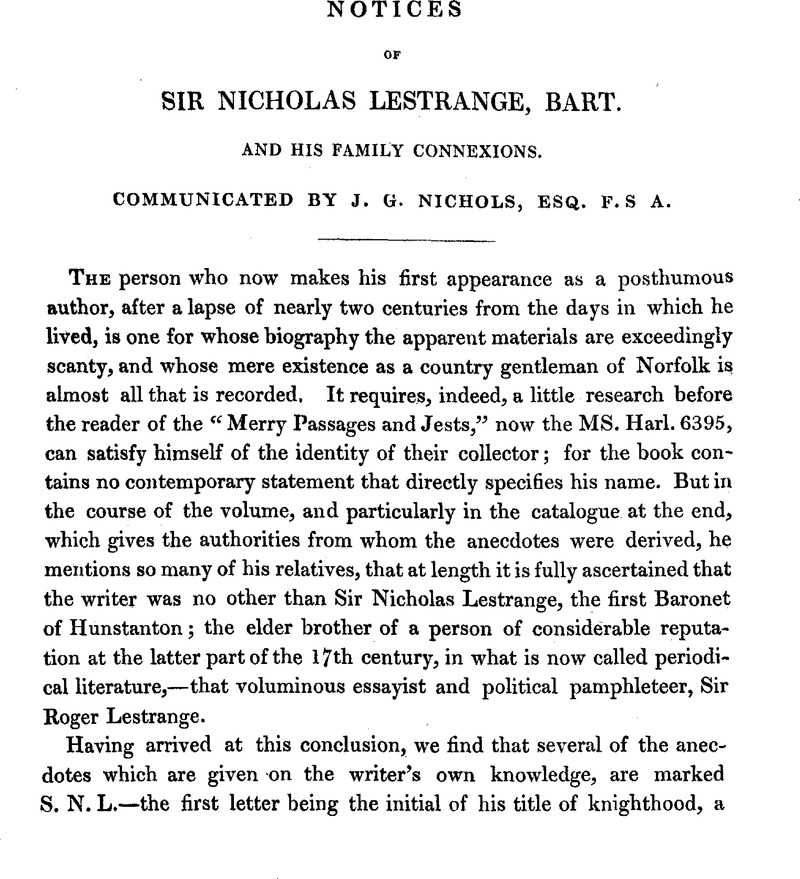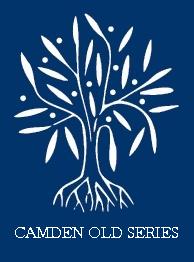No CrossRef data available.
Article contents
Notices of Sir Nicholas Lestrange, Bart and his family connexions
Published online by Cambridge University Press: 23 February 2010
Abstract

- Type
- Notices of Sir Nicholas Lestrange, &c.
- Information
- Camden Old Series , Volume 5: Anecdotes and Traditions, illustrative of Early English History and Literature , August 1839 , pp. xi - xxviii
- Copyright
- Copyright © Royal Historical Society 1839
References
page xiii note a “A wench came to my Grandmother Stubbe to seeke a service,” &c No. 358.
page xiii note b Pedigree by Le Neve in the College of Arms: but perhaps we should read 1585. Her epitaph at Hunstanton (in the History of Norfolk, 1809, vol. x. p. 326,) states her age at her death to have been 71; in which case she was two years older than her husband, which is not improbable, as she was the daughter of his great-aunt.
page xiv note c See Wood's Athenæ Oxon. by Bliss, ii. 527; iii. 201, 563.
page xiv note d An original portrait of Sir Roger, by Kneller, which it is believed has never been engraved, is in the possession of Richard Frankum, Esq. a member of the Camden Society.
page xv note e There is a pamphlet in the British Museum, printed in 1683, attacking him under the title of “The Loyal Observator; or, Historical Memoirs of the Life and Actions of Roger the Fidler; alias, The Observator.”
page xv note f See the case of “Henry Le Strange Styleman, of Hunstanton, in the county of Norfolk, Esq. on his claim to the title and dignity of Baron Camoys,” in the House of Lords, Session 1838; also the “Minutes of Evidence given before the Committee of Privileges, to whom the Petition of Thomas Stonor, of Stonor, Esq. claiming to be the senior co-heir of the Barony Camoys, was referred.” Printed by order of the House of Lords, 1838.
page xvi note g Their marriage settlement was made by an indenture quadripartite, dated the 25th Aug. 1630, between Sir Hamon Le Strange, of Hunstanton, Knight, and Dame Alice his wife, of the first part; Sir Nicholas Le Strange, Baronet, son and heir apparent of the said Sir Hamon and Alice, of the second part; Dame Mary Lewkenor, the relict of-Sir Edward Lewkenor, late of Denham in Suffolk, deceased, Richard Catline, of Lakenham, in the county of the city of Norwich, Esq. and Thomas Catline, of Norwich, gentleman, of the third part; and John Spelman, Esq. son and heir-apparent of Sir Henry Spelman, of Congham, in Norfolk, Knt. and Sir Robert Walpole, of Houghton, co. Norfolk, of the fourth part. This document is printed at length in the Minutes of Evidence mentioned in the last note, pp. 378–391. Among the witnesses to its execution were Fra. Bacon, Valentine Pell, Edward Gourney. The two latter persons will be noticed hereafter; and Fra. Bacon was, perhaps, “Mr. Bacon the lawyer “mentioned in p. 9 of the present volume, as the Chancellor is duly called “the Lord Verulam “two pages after.
page xvi note h Printed in the Minutes of Evidence (as above), p. 170.
page xvi note i See her will, made in the previous year, ibid. p. 208.
page xvii note j Sir William Russell (the father) was himself Treasurer of the Navy; and held that office in 1633, at the period of the settlement on the marriage of his daughter with “Ned Lewkenor,” which will be found in the Minutes of Evidence on the Camoys Peerage, 1838, p. 371.
page xvii note k Sir John Potts, mentioned in the same anecdote (see p. 79,) was one of the Members for the county of Norfolk, and took the Solemn League and Covenant.
page xvii note l Three alliances took place between the family of Sir Francis Russell and that of the Protector. His son and heir Sir John married Frances, the Protector's youngest daughter, widow of the Hon. Robert Rich (who died in 1657–8); his daughter, Elizabeth Russell, was married (about 1655), to Oliver's younger son Henry, the Lord Lieutenant of Ireland; and, thirdly, Elizabeth Cromwell, one of the offspring of the last-named couple, was married to William Russell, of Fordham, co. Camb. esq. nephew to Sir Francis.
page xviii note m Epitaphs at East Barsham. See her Will in the Evidence on the Camoys Peerage, 1838, p. 196; witnessed by Elizabeth Spring and Mary Lewkenor (her sister).
page xviii note n See the History of Norfolk, vii. p. 46, for his descendants.
page xviii note o This Sir Edward Lewkenor died and was buried at Denham in 1605. See in Evidence on the Camoys Peerage, p. 160, his funeral certificate, signed by “Thomas Gurnay,” among others.
page xix note p “Independently of this connexion through the family of Stubbe, the Gurneys were related to the Lestranges through the Calthorpes and Heydons: and an old pedigree at Hunstanton gives a marriage of Lestrange and Gurney, but I have not met with a confirmation of this. The only coat of arms in glass remaining at Hunstanton Hall, previous to the late alterations, was Lestrange impaling Gourney; but I think this was intended for Heydon, the arms of which family are nearly similar to those of Gurney.” Communication of Daniel Gurney, esq. of North Runcton in Norfolk, F.S.A. to whom the writer begs to acknowledge his obligations for various information. J. G. N.
page xx note p Pedigree of Lewkenor, and Morant's Essex, i. 68, where the Poet is erroneously named James.
page xx note q The story told by “My Aunt Nevill” is a very trifling one of her brother-in-law Sir Richard Brooke when a boy.
page xx note r See the note in p. xvi, antea.
page xx note s History of Norfolk, viii. 35.
page xxi note t It is to this lady that the trifling story told by Sir Henry Yelverton's lady (No. 23), relates: “Old Sir Will. Yelverton's lady (my aunt) reading the fourteenth verse of Mathew, the eighth chapter, where Peter's wives mother lay sicke of a feaver, reade that Peter's wives mother lay sicke of a feather-bedde.”
page xxii note u A monument was erected to him and his father at Rougham by John Bladwell, esq.; see the anecdote of “old Bladwell” in p. 7.
page xxii note x This is William the fifth Earl, who succeeded his father in that title in 1641, and who, in his old age, was created a Duke by King William the Third in 1694. His sister Margaret was the wife of James Hay, second Earl of Carlisle of that family. See in Wiffen's Memorials of the Russells, vol. ii. p. 129, an elaborate eulogy on the “feminine reserve and delicacy” of her aspect, a character which the present anecdote by no means tends to support. Nor is her “reserve” exhibited in another anecdote which has recently appeared: “Some say the Countess of Carlisle gave secret intelligence to the Five Members and Kimbolton of the King's design, and so they fled into the Cittie.” Diary [or rather Common-place-book] of the Rev. John Ward, 8vo. 1839, p. 152.
page xxiii note y See memoirs of Sir John Spelman in Athenæ Oxon. (edit. Bliss,) iii. 62. He was another of the parties to Sir Nicholas Lestrange's marriage settlement, as mentioned in the note, p. xvi.
page xxv note z Epitaphs at Congham; Hist, of Norfolk, 1808, viii. 388.
page xxv note a Epitaphs at Dersingham.
page xxvi note b Another was Capt. Clinch, who was the authority for Nos. 531 to 534, 545, 548, and 550 of Sir Nicholas's Anecdotes.
page xxvi note c This was either Colonel Francis Russell, already noticed in p. xvii, or his brother Colonel John Russell, an officer who distinguished himself both in the battle of Marston Moor, and in Oliver's army employed against Spain.
page xxvii note q The time of this political contest was probably the election of the Long Parliament in 1640. Like other political aspirants, Mr. Frere was not easily discouraged, and we find he was actually elected one of the Members for Norfolk to the Short, or Barebones, Parliament of 1653; and again to Cromwell's second Parliament in 1654. He was, by purchase, of Redenhall in Norfolk, in the church of which parish is a Latin epitaph recording his death on the 6th Feb. 1655, in his 66th year (see History of Norfolk, 1806, v. 365), and also on his gravestone the following:
“Tobias Frere, Esq. Febr. 6, 1655, His Corps lye here: his Soule, like to the dove, Finding small rest below, now rests above.”
page xxvii note r In all the publications on the Baronetage, including Courthope's “Synopsis of the Extinct Baronetage of England,” 1835, and Burke's “Extinct and Dormant Baronetcies of England,” 1838, this Sir Hamon has been omitted in the descent of the title. The date of his death, and the circumstance of his dying unmarried, were proved before the House of Lords, by the epitaph and arms still on the graavestone in the chancel at Hunstanton. —Minutes of Evidence on the Camoys Peerage, 1838, p. 392.
page xxviii note s The good things which Sir Nicholas has recorded, on the part of his faithful wife, are generally of the most trifling description, and among them is the following, the only one it is believed in which he mentions any of his children: “Fil. me. Nick, reading the chapter of Salutations, Colos. 4, 9, instead of Onesimus, read the word divided thus, with One simus, &c.” No. 556. “My Wife.”


